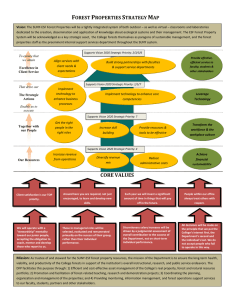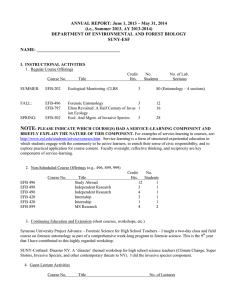ANNUAL REPORT: June 1, 2011 – May 31, 2012
advertisement
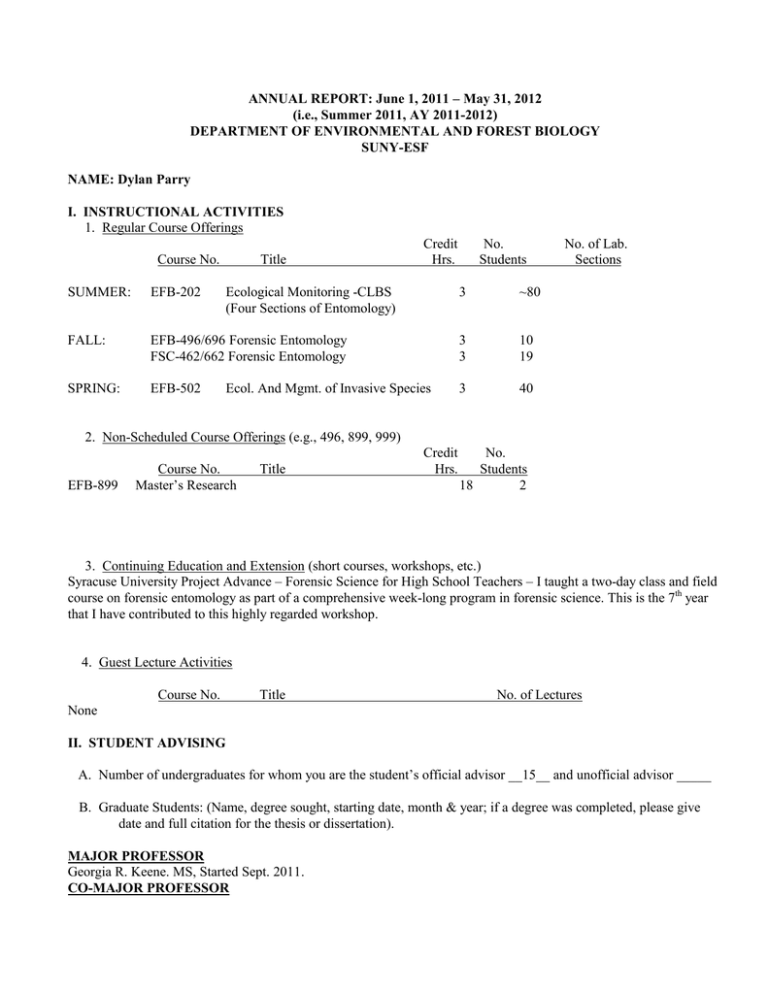
ANNUAL REPORT: June 1, 2011 – May 31, 2012 (i.e., Summer 2011, AY 2011-2012) DEPARTMENT OF ENVIRONMENTAL AND FOREST BIOLOGY SUNY-ESF NAME: Dylan Parry I. INSTRUCTIONAL ACTIVITIES 1. Regular Course Offerings Course No. SUMMER: EFB-202 FALL: SPRING: Title Credit Hrs. Ecological Monitoring -CLBS (Four Sections of Entomology) No. Students 3 ~80 EFB-496/696 Forensic Entomology FSC-462/662 Forensic Entomology 3 3 10 19 EFB-502 3 40 Ecol. And Mgmt. of Invasive Species No. of Lab. Sections 2. Non-Scheduled Course Offerings (e.g., 496, 899, 999) EFB-899 Course No. Master’s Research Title Credit Hrs. No. Students 18 2 3. Continuing Education and Extension (short courses, workshops, etc.) Syracuse University Project Advance – Forensic Science for High School Teachers – I taught a two-day class and field course on forensic entomology as part of a comprehensive week-long program in forensic science. This is the 7th year that I have contributed to this highly regarded workshop. 4. Guest Lecture Activities Course No. Title No. of Lectures None II. STUDENT ADVISING A. Number of undergraduates for whom you are the student’s official advisor __15__ and unofficial advisor _____ B. Graduate Students: (Name, degree sought, starting date, month & year; if a degree was completed, please give date and full citation for the thesis or dissertation). MAJOR PROFESSOR Georgia R. Keene. MS, Started Sept. 2011. CO-MAJOR PROFESSOR Christopher R. Standley (MS) Started 01/10, Completed 05/12. Thesis title: Emergence Phenology and Ecological Interactions Between the Exotic Sirex noctilio, Native Siricids, and a Shared Guild of Native Parasitoids. 100 pp. (CoAdvised with M. Fierke) MEMBER, STEERING COMMITTEE (other than those listed above) Joelle Chille (MS) Daniel M. Cucera (MS) Chris Foelker (PhD) CHAIRMAN OR READER ON THESIS EXAMS, ETC. III. RESEARCH COMPLETED OR UNDERWAY A. Departmental Research (unsupported, boot-legged; title - % time spent) Forest tent caterpillar dynamics and long-term effects on forests. This research has been partially supported in some years, and bootlegged in other years. I have developed a long-term monitoring grid so as to better understand the temporal changes in abundance of this insect. Since its population cycles are approximately decadal, this represents a very long time commitment, far longer than any grant will support, and thus will continue to be bootlegged, perhaps for the duration of my career. I spend approximately 10% of my annual research time on this project. Other researchers are beginning to recognize the potential utility of this long-term data and some fruitful collaboration is likely to arise in the next year. Adaptive change in gypsy moth and range expansion. I am extending some of the gypsy moth research that was originally funded by McIntire-Stennis while developing proposals to further support this research. Partial support has come from the USDA-Forest Service gypsy moth project with which I am involved (see below). In the mean time, I will spend about 15% of my research time on this project. This was the focus of my NSF pre-proposal that was not selected for a full proposal. Given that the reviews were quite good, I will revise and resubmit and will also modify for submission to the USDA NIFA-AFRI foundational grant RFP in August. Non-target Effects of Transgenic American Chestnut on Natural Enemies of Insect Herbivores. In conjunction with funded research on transgenic American chestnut on insect herbivores, I have been conducting spin-off research on non-target effects on insect natural enemies, particularly biological pesticides. I will pitch these pilot studies in a research grant proposal to either the EPA or USDA BRAG (or both) in the upcoming year (15% of annual research time) Integrating Insect Herbivores into a more comprehensive understanding of forest response to climate change. I have initiated pilot research with Colin Biere and Greg Lawrence (USGS) to add an insect component to their longterm climatological work in the Adirondacks (5% of annual research time, something that will undoubtedly increase). Developing sampling methodology for Barrens Buck Moth (with Brian Underwood and Neil Gifford (Albany pine Bush). This research is the heart of graduate student Georgia Keene’s research. Barrens buck moth is one of the best indicator organisms for quality scrub-oak / pitch pines barrens but has proven difficult to census effectively. We are trying to interest the NY DEC in this research as it will have broad applicability / utility to pine barrens in general (15% of annual research time) B. 1. Grant-supported Research (source, subject, amount - total award and current year, award period starting and ending dates; list graduate research assistants supported by each grant) Parry, D., USDA- Forest Service. Climate Controlled Reproductive Asynchrony and Mating Success in Gypsy Moth Populations. 2011-2012. $19,500. Although not part of Georgia Keene’s thesis topic, she worked on some elements of this project and will present some of the research at the Entomological Society of America National meeting in Knoxville, TN. Fierke, M., D. Parry and D. Allen. McIntire-Stennis. Evaluating Impacts of Native Parasitoids on Sirex noctilio in New York. $79,000. 2009-2012. (provided support for Chris Standley and partially, Joelle Chille) W. Powell, C. Maynard, D. Parry, C. Nowak, R. Briggs. USDA Biotechnology Risk Assessment Grants (BRAG) program. Evaluating Environmental Impacts Of Transgenic American Chestnut Trees To Chestnut Trees Produced By Conventional Breeding. $499,985. 2012-2015. Note, we were notified in May 2012 that it will be funded, but actual amount has not yet been determined. Will support one graduate student in my lab (to be recruited) 2. Research Proposals pending (include information as in B.1, above). 3. Research Proposals submitted, but rejected (include information as in B.1, above) Parry, D. and M.K. Fierke. USDA AFRI. Phenology and Performance of the Invasive European Woodwasp, Sirex noctilio, its Parasitoids, and Native Siricid Competitors on Two Species of Pine. $286,000 Parry, D. National Science Foundation. Preliminary Proposal: Assessing adaptive changes to the ecology of a widespread, generalist invasive insect along a latitudinal gradient. Fierke, M.K., C.M. Whipps, D. Parry, National Science Foundation. Preliminary proposal: Superabundant Invader Influences on Parasitism of Native Congeners. Fierke, M.K., D. Parry, C. Nowak, K. Wallin. NSRC. Influence of Historical Silvicultural Treatments on Colonization Patterns, Community Interactions, and Host Defenses associated with Sirex noctilio at a Long-term Ecological Study Site. $125,000 Fierke, M.K., C.M. Whipps, D. Parry. Developing molecular markers for native parasitoids of Sirex noctilio. ESF Seed grant. $8000. IV. PUBLICATIONS (Full bibliographic citation, i.e., do not use "with Jones," or "Jones, et al."; please list only publications published, in press, or actually submitted during this reporting period --- do not list manuscripts in preparation). A. Refereed Publications Parry, D. 201x Egg hatch in an outbreak defoliator is independent of bud break phenology despite large fitness costs. Oecologia. Submitted MS. Note – this was withdrawn, revised, and resubmitted after discussion with Editor Standley, C., R. Hoebeke, D. Parry, D. Allen, M. Fierke. 2012 Detection and Identification of two new native hymenopteran parasitoids associated with the exotic Sirex noctilio in North America. Proc. Entomol. Soc. Washington. 114: 238-249. Post, K.H. and D. Parry. 2011. Non-target effects of transgenic blight-resistant American chestnut (Fagales: Fagaceae) on Insect Herbivores. Environmental Entomology. 40: 955-963 B. Non-refereed Publications Tobin, P.C., D. Parry, B.H. Aukema. 201x. The Influence of Climate Change on Insect Invasions in Temperate Forest Ecosystems. Accepted Manuscript. In Challenges and Opportunities for the World’s Forests in the 21st century, T. Fanning (ed). Springer Academic Press. (53 manuscript pages) Parry, D., and S.A. Teale. 2011. Alien Invasions: The Effects of Introduced Species on Forest Structure and Function. Pp 115-162 in Forest Health: An Integrated Perspective, ed. J. D. Castello and S. A. Teale. Cambridge University Press. New York, NY. 372 pp. (Published June 2011) C. Papers Presented at Science Meetings (give title, date, occasion, and location) Parry, D. Latitudinal Variation in Life-History Traits among North American Gypsy Moth Populations. Invited talk. USDA Forest Service Interagency Research Forum on Invasive Species, 01/12. Annapolis, MD. Parry, D. Legacy Biological Control as the Driver of Giant Silk Moth Decline in the Northeast? Northeast Natural history Conference. Syracuse, NY. 04/2012 Standley, C.R., D. Parry, D. Allen, M. Fierke. Degree day emergence of Sirex noctilio (F.) and its native siricids complex in New York. Presentation. 1/2012, New York Society of American Foresters Ann. Meeting, Syracuse NY. Standley, C.R., D. Parry, D. Allen, M. Fierke. Degree day emergence of Sirex noctilio (F.) and its native siricids complex in New York. Poster. 1/2012, USDA Annual Interagency Research Forum on Invasive Species, Annapolis, MD. D. Public Service Presentations (lectures, seminars, etc. to and for the public; give group or occasion, date(s), and attendance) V. PUBLIC SERVICE A. Funded Service (include consulting activities) 1. Government Agencies (Federal, State, Local): 2. Industrial and Commercial Groups, etc. B. Unfunded Service to Governmental Agencies, Public Interest Groups, etc. Member, New York State Invasive Species Advisory Council Albany Pine Bush Preserve. I have continued a long-standing relationship with the Albany Pine Bush preserve. The director, Neil Gifford, and I have collaborated on numerous projects, and I provide consultation on the effects of management on insect species that are of conservation concern. Although there is no direct compensation, we benefit through free labor from preserve staff and occasional housing for graduate students. Brian Hoven (MS 2010), in particular, was availed a significant amount of Pine Bush resources during the implementation of his project. My new MS student, Georgia Keene, is working in the Preserve as well. As a goodwill ambassador for ESF, I was able to connect Bill Shields with the APBP, facilitating opportunities for honors student internships within the preserve. NY DEC. I share ecological information on insect defoliators and exotic forest pests with Jerry Carlson, head of Forest Protection for NY-DEC. In addition, I have been running a pilot study on the use of forest tent caterpillar pheromone as a monitoring tool and coordinating sites with the DEC so that we can compare their traditional sampling methods with this new tool. The DEC will fund trapping costs (fuel, pheromone, traps, etc.). Jerry has been providing a state vehicle and gas, which given the thousands of miles of driving this project entails, is a real important contribution. Project Advance – Syracuse University, Forensics for High School teachers. I continue to run a two-day workshop each summer for the best and brightest high school science teachers in the state. I run a forensic entomology lab for them and teach them how to introduce this material into their own teaching programs. As forensic science is a great way to gain and keep student interest in biology, this program is in high demand. Although I get a token honorarium, the time investment is significant and thus is functionally un-compensated. VI. PROFESSIONAL DEVELOPMENT A. Professional Honors and Awards (for teaching, research, outreach, etc.) B. 1. Activities in Professional Organizations (offices held, service as chairman, member, participant or consultant) Member, New York State Invasive Species Advisory Council (Not sure whether this should be listed here or as unfunded governmental service (or in both). It does have a designated legislative charter and is composed of professionals. Member, New York Forest Health Advisory Group. Share information, collaborate and coordinate activities of academic and government agencies involving major threats to the health of New York’s forests. 2. Professional Society Membership Ecological Society of America Society for Conservation Biology Entomological Society of America 3. Other Professional Activities a. Editorial activity Journal (s) Responsibility Other (books, symposia, etc.) Organized and moderated a session on Insect Diversity and Conservation at the Northeast Natural History Meeting. b. Reviewer Journal(s) Canadian Journal of Forest Research Environmental Entomology Journal of Weed Science Oikos No. of manuscripts (1) (1) (1) (1) Biological Control (1) Agency No. of proposals Other MacIntire-Stennis. Read, reviewed and ranked 8 pre-proposals, 3 full proposals ESF Seed Grants Read, reviewed and ranked 3 Proposals c. Participation (workshops, symposia, etc.) Name of workshop, etc. Date Place C. Further Education/Re-training Undertaken, Leaves, Workshops, etc. D. Foreign Travel (Where, When, Purpose) VII. ADMINISTRATIVE AND SERVICE RESPONSIBILITIES (include committee participation) A. Department-level -Chair the LeRoy C. Stegeman Award in Invertebrate Ecology committee; evaluate applications, and present award (as I have done since 2003) -Ad hoc committee member, Burgess Award. -Member GPAC (Graduate x Advisory Committee) B. College-level - Member, Committee on Research. Committee members evaluated and ranked McIntire-Stennis pre-proposals and full proposals, reviewed and ranked Seed Grant Proposals, determined this year’s exemplary ESF researcher, and organized and convened the Spotlight on Research. - Judge, Spotlight on Research (Ranked a subset of graduate student posters) - Member and stand in Chair (for Ken Tiss), Academic Integrity Committee. Convened hearings for students accused of academic integrity violations, evaluated the evidence, upheld or dismissed cases based on the documentation, and recommended punishments where appropriate. C. University-wide, including Research Foundation VIII. SUMMARY OF SIGNIFICANT ACTIVITIES AND ACCOMPLISHMENTS DURING THIS REPORTING PERIOD, ESPECIALLY THOSE MOST NOTEWORTHY AND RELATIVE TO THE COLLEGE’S AND DEPARTMENT’S MISSION. One paragraph on each of the following would be most helpful: this past year, what have you done for our students, department/college, and self professionally? NOTE: The information in this section (along with the supporting specific information elsewhere in this report) should be your strongest case for being considered for a discretionary raise, which I’ll continue to award based on your contributions to the department and college this reporting period. Students: Fall semester marked the first time I taught a full 3-credit forensic entomology course at ESF. This was in addition to teaching it at Syracuse University where I engage a very different audience (primarily graduate students in the forensic science program). This was by far the most labor-intensive course I have ever taught, with more than 2/3rds of the classes in the field at either Lafayette Rd Field Station or at Heiberg Forest, or in the laboratory. The course utilizes simulated homicide investigations, which necessitates extensive crime scene and ‘victim’ (100 lb euthanized swine) preparation, the transport and deployment of an array of analytical and sampling equipment in a variety of field settings and the oversight and / or care of large quantities of living insect evidence and temperature data collected by the students and critical to their post-mortem interval calculations. Decomposition is a highly temperature dependent process which introduces a lot of unpredictability into planned activities (and syllabus sequences!) but on the whole, I was very pleased with how the course went and will build on the experience (and diligently promote the class) to increase enrollment up to a logistical cap in Fall 2013 when it will next be offered. Feedback from the SU listed course (the e-evaluations at ESF were useless with only 2 respondents) were the best I’ve gotten in any class over my teaching career. In spring 2012, I again taught EFB-502, continuing to add new components to this course to keep it fresh and current in this rapidly developing field and I turned over more than 25% of the lecture material this year. Often not recognized is the large input effort required to teach a course of this size with continued utilization of labor-intensive written exams and projects. Having taught a large service course with TA support, I can attest that instructing a demanding upper division course without TA’s is considerably more time demanding. While it would be easy to use a SCANTRON format, my philosophy has always been that the value of multiple choice tests are limited and that student learning is best when they are required to synthesize material in solving the kind of problems they will encounter in the real world. Perhaps this is why this course continues to get excellent evaluations from the majority of students that take it (~ 4.75 average on evaluations). On the graduate side, Chris Standley, (co-advised with M. Fierke) finished a very comprehensive MS in May with a paper already published in a solid journal and a couple more ready for submission. New MS student Georgia Keene started her research in the Albany Pine Bush, and Giovan Girardi, a self-funded MS student will start this summer. Recruitment has proved challenging as one of the top-ranked PhD students whom I had cultivated over an extended period of time ultimately turned down a very competitive fellowship and financial package to work in my lab to pursue a PhD elsewhere. I hope to bring a student on at the PhD level to work on the transgenic chestnut project once that funding is in place – this student would be eligible to apply for EPA STAR fellowship through the connection to their scientific mandate I outlined above. I served on the GPAC committee this year in an effort to enhance our graduate program. We made headway on changing the evaluation process of graduate applications to better identify candidates that are going to succeed in the metrics that are important in graduate studies. GPAC also worked on identifying areas where the graduate program can improve and evaluated the candidates for Outstanding Graduate Student Award. In addition, I oversaw the Stegeman Award process and was once again able to provide a well-deserving student with an award and some supplemental funds for research. Department and College: I served on two college-wide committees this year, COR and have been a member and stand-in chair for hearing academic integrity violations. I represent the college’s interests as a member on the sNY State Invasive Species Advisory Committee, a group of governmental, non-profit, private sector, and academic organizations who function to advise NY State on invasive species issues and help to craft legislation that effectively combats targeted species or pathways. Although budget cuts have taken a toll on the organization, we were still able to play a large role in developing and changing the forth-coming ‘clean-boat’ bill that should clear any legislative hurdles this year. The Northeast Natural History Conference was held in Syracuse in 2012 and provided a good opportunity for ESF to showcase faculty and students. I took the initiative to organize and moderate a session entitled “Insect Diversity and Conservation” which was well attended and for which I received a lot of positive feedback on both the quality of the presentations and the breadth of topics. Self: This was a challenging year both personally (birth of my son in September, death of my father in May) and professionally. The current budgetary situation at the federal and state level has fallen particularly hard on forest entomology in the Northeast. Long gone are the days of the so-called “big-bug” projects that built many forest entomology programs and research careers across the US from the early 1970’s through the 1990’s. In the past 10 months for example, in the northeast, the US Forest Service has released just one RFP relevant to entomology and it focused on a very limited area of research (developing attractant lures for detection) for two invasive insects. As such, I have begun to re-focus my program, as funding sources for the more fundamental, ecologically focused forest entomology with which I built my career do not appear likely in the near future. This has proved challenging, as it is hard to develop novel research in new fields with already established scientists. However, I have begun two collaborations with researchers working on climate change, one on integrating insects into understanding the effects on forests (Colin Beier and Greg Lawrence - USGS), and with another group looking at the effects of climatic shifts on invasive insects (see the comprehensive book chapter in publications section). My association with the transgenic American chestnut program has also proved fruitful with former MS student Keith Post (2009) publishing a paper on non-target effects of transgenic trees on insect herbivores this past year, and we (Powell et al.) recently received confirmation of another round of significant USDA funding (~500 K) to continue research on the system. The publication of Castello and Teale’s Forest Health book in June 2011 generated some very favorable press for the college over the past year and my invasive species chapter was one singled out for excellence in a recent book review in the high profile journal Ecology. My nomination to the National Invasive Species Advisory Council was submitted and is currently pending. If approved, this would give ESF a high profile spot on a very important and respected body with significant input into federal invasive legislation and policy. IX. A. FUTURE PLANS, AMBITIONS, AND POTENTIAL CONTRIBUTIONS FOR YOUR OWN PROFESSIONAL DEVELOPMENT AND THE ENHANCEMENT OF THE PROGRAM IN ENVIRONMENTAL AND FOREST BIOLOGY (brief summary) My biggest focus over the next year will be a continued effort to broaden and refocus my program at ESF. Although I’ll still remain active in some of my core research initiatives, I am actively pursuing opportunities in some novel areas that may be more fruitful from a funding perspective. I’ve been invited to give a talk at the Entomological Society of America National Meeting in Knoxville in one of the featured symposia (Forest Entomology in an Era of Global Change), a high profile venue. I’ll be submitting a grant proposal to the USDA-AFRI call in mid-August (with Patrick Tobin USDA-FS) and another one to the USDA Climate Change RFP in October. Currently, I am working on two of recent MS Chris Standley’s manuscripts from his MS and a paper aimed at BioScience (Tobin, Parry, Aukema) on climate change and insect invasions. From a college service perspective, I’ll serve another year on the Committee on Research and will continue to adjudicate Academic Integrity hearings. At the department level, I’ll continue to be active with GPAC. I am now an adjunct professor in the newly established Forensic Science and National Security Institute at Syracuse University and will engage with students in that program, especially graduate students pursuing the professional masters degree in forensic science. My involvement with the institute both directly and indirectly benefits my teaching program at ESF – indirectly, interactions with students and faculty in the program keeps me on top of cutting edge research and technology in forensic science, knowledge that I bring back to ESF through my course, and directly as significant resources available for my course at SU were also utilized in my ESF course saving us money and providing ESF students with a better experience. B. PROJECTED ACTIVITIES FOR NEXT YEAR 1. Summer 2012 a. Course(s) to be offered EFB-202, Entomology Section, July 11-14 b. Proposed research activity -USDA BRAG – large scale bioassays of the experimental chestnuts with several insect species. -USDA Forest Service – Mating success and climatic asynchrony experiments with gypsy moth. -Coupling ongoing long-term forest tent caterpillar research with sugar maple climate change plots. c. University, professional society, and public service SUPA – Forensic Entomology for Teachers Workshop (June 25-26) NY Invasive Species Advisory Council (two meetings) 2. Fall Semester 2011 a. Course(s) to be offered EFB 504 Plant-Herbivore Interactions EFB 797 Current Topics in Insect Ecology: Insects and Climate Change b. Proposed research activity Finish and submit BioScience manuscript USDA AFRI foundational grant USDA AFRI climate change grant c. University, Professional society, and public service -College-wide Committee on Research -NY Invasive Species Advisory Council 3. Spring Semester 2012 a. Course(s) to be offered EFB 502 Ecology and Management of Invasive Species EFB 797 Graduate seminar (potentially conservation of invertebrates, possibly with Rebecca Rundell?) b. Proposed research activity USDA BRAG supplemental or full proposal c. University, professional society, and public service -Committee on Research -NY Invasive Species Advisory Council
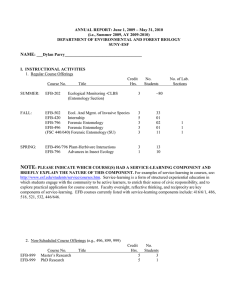
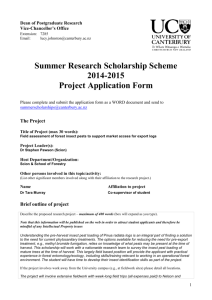
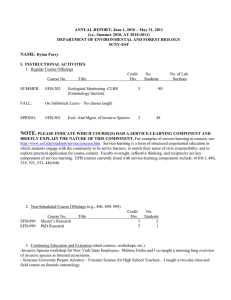
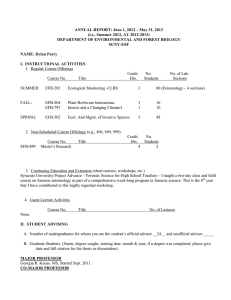
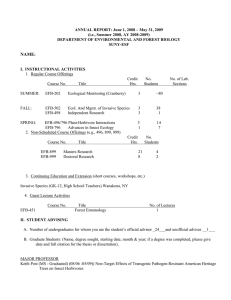

![[Type text] [Type text] Prof. Sandy M. Smith's Invasive Species Lab](http://s3.studylib.net/store/data/008211227_1-e00888e6c97e7f0ad17a5ec826a8ce37-300x300.png)
